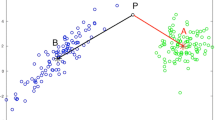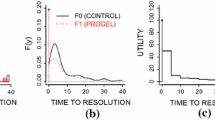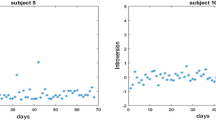Abstract
A modification of the TUCKALS3 algorithm is proposed that handles three-way arrays of order I × J × K for any I. When I is much larger than JK, the modified algorithm needs less work space to store the data during the iterative part of the algorithm than does the original algorithm. Because of this and the additional feature that execution speed is higher, the modified algorithm is highly suitable for use on personal computers.
Similar content being viewed by others
References
Bentler, P. M., & Lee, S.-Y. (1978). Statistical aspects of a three-mode factor analysis model.Psychometrika, 43, 343–352.
Bentler, P. M., & Lee, S.-Y. (1979). A statistical development of three-mode factor analysis.British Journal of Mathematical and Statistical Psychology, 32, 87–104.
Bentler, P. M., Poon, W.-Y., & Lee, S.-Y. (1988). Generalized multimode latent variable models: Implementation by standard programs.Computational Statistics and Data Analysis, 6, 107–118.
Bloxom, B. (1968). A note on invariance in three-mode factor analysis.Psychometrika, 33, 347–350.
Browne, M. W. (1984). The decomposition of multitrait-multimethod matrices.British Journal of Mathematical and Statistical Psychology, 37, 1–21.
Cliff, N. (1966). Orthogonal rotation to congruence.Psychometrika, 31, 33–42.
Kiers, H. A. L., & Krijnen, W. P. (1991). An efficient algorithm for PARAFAC of three-way data with large numbers of observation units.Psychometrika, 56, 147–152.
Kroonenberg, P. M. (1983).Three-mode principal component analysis. Leiden: DSWO Press.
Kroonenberg, P. M., & de Leeuw, J. (1980). Principal component analysis of three-mode data by means of alternating least squares algorithms.Psychometrika, 45, 69–97.
Kroonenberg, P. M., ten Berge, J. M. F., Brouwer, P., & Kiers, H.A.L. (1989). Gram-Schmidt versus Bauer-Rutishauser in alternating least-squares algorithms for three-mode principal component analysis.Computational Statistics Quarterly, 5, 81–87.
Lawson, C. L., & Hanson, R. J. (1974).Solving least squares problems. Englewood Cliffs, NJ: Prentice-Hall.
Lee, S.-Y., & Fong, W.-K. (1983). A scale invariant model for three-mode factor analysis.British Journal of Mathematical and Statistical Psychology, 36, 217–223.
McDonald, R. P. (1984). The invariant factors model for multimode data. In H. G. Law, C. W. Snyder, J. A. Hattie, & R. P. McDonald (Eds.),Research methods for multimode data analysis (pp. 285–307). New York: Praeger.
Murakami, T. (1983). Quasi three-mode principal component analysis—A method for assessing the factor change.Behaviormetrika, 14, 27–48.
Tucker, L. R. (1966). Some mathematical notes on three-mode factor analysis.Psychometrika, 31, 279–311.
ten Berge, J. M. F., de Leeuw, J., & Kroonenberg, P. M. (1987). Some additional results on principal components analysis of three-mode data by means of alternating least squares algorithms.Psychometrika, 52, 183–191.
Verhees, J. (1989).Econometric analysis of multidimensional models. Unpublished doctoral dissertation, University of Groningen.
Verhees, J., & Wansbeek, T. J. (1990). A multimode direct product model for covariance structure analysis.British Journal of Mathematical and Statistical Psychology, 43, 231–240.
Weesie, H. M., & Van Houwelingen, J. C. (1983).GEPCAM users' manual: Generalized principal components analysis with missing values. Unpublished manuscript, University of Utrecht, Institute of Mathematics.
Author information
Authors and Affiliations
Additional information
This research has been made possible by a fellowship from the Royal Netherlands Academy of Arts and Sciences to the first author.
Rights and permissions
About this article
Cite this article
Kiers, H.A.L., Kroonenberg, P.M. & ten Berge, J.M.F. An efficient algorithm for TUCKALS3 on data with large numbers of observation units. Psychometrika 57, 415–422 (1992). https://doi.org/10.1007/BF02295429
Received:
Revised:
Issue Date:
DOI: https://doi.org/10.1007/BF02295429




